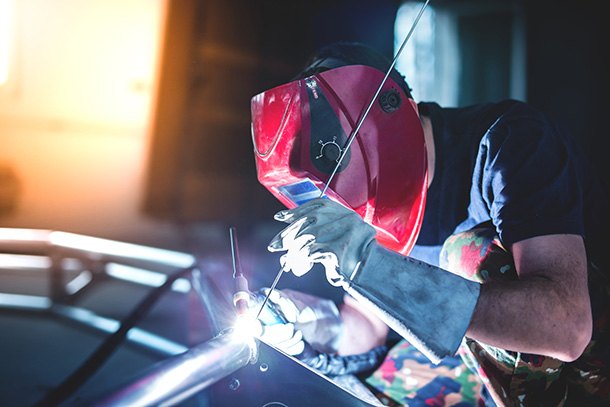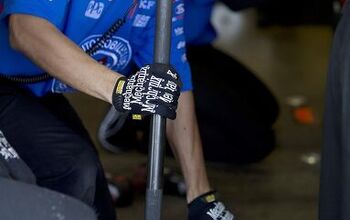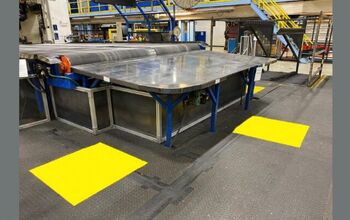Best Welding Gloves: Just Glovely

Top 8 Best Welding Gloves
Following up our list about welding helmets we felt it appropriate to compile a list of welding gloves. After all, you’re not trying to stick metal together with your bare hands are you? And that pair of cotton gloves is totally inadequate, by the way.
A good pair of welding gloves should be thick enough to protect your hands and long enough to protect at least part of your forearms. Wearing a too-small pair that is akin to using a scuba mask that doesn’t fit your face; things are going to leak, it’ll be hella uncomfortable, and you’ll generally have a poor experience.
Here are eight options we found on Amazon. Now, please reserve those cotton gloves solely for taking out the trash.
Table of Contents
-
Editor's Choice: Miller Electric MIG Welding Gloves: Shop Now
-
AmazonBasics Welding Gloves: Shop Now
-
Lincoln Electric Traditional MIG/Stick Welding Gloves: Shop Now
-
QUANOVO Long Sleeve Welder Gloves: Shop Now
-
Revco Top Grain Leather Cowhide Welding Gloves: Shop Now
-
MAGID Inferno Series Impact Welder's Gloves: Shop Now
-
Lincoln Electric Heat Resistant Welding Gloves: Shop Now
-
RAPICCA Leather Welding Gloves: Shop Now
1. Editor's Choice: Miller Electric MIG Welding Gloves
From the pros at Miller Electric we find this pair of gloves with a pig split leather palm and abrasion-resistant cuff. Multi-layered insulation is designed to wick moisture away from your disgustingly sweaty palms while a sheet of foam should improve comfort.
Those pre-curved fingers are ergonomically designed to facilitate grasping welding materials, while the keystone thumb design adds a bit of dexterity. It's what separates us from creatures devoid of opposable digits, y'know. Flame resistant Kevlar is fun to say and comprises the tread along this glove's seams.
Pros
- Trusted brand name, it's got Kevlar thread!
Cons
- Boring colors
Bottom Line
- A get-the-job-done tool from those who know best
2. AmazonBasics Welding Gloves
There's an excellent chance that the Amazon brand will eventually appear on just about every consumer product on this planet, though the first time I drink an Amazon beer will be a sad day, indeed. These welding gloves seem perfectly serviceable for the price and are even offered in a trio of colors. Pro tip: choose red or blue.
Amazon says these leather gloves offer complete defense against molten metal, ultraviolet rays, and hot embers. However, Amazon says lots of things so it's best to turn to the 100+ real-world reviews. Fortunately, the 4.5 out of 5-star rating largely back these assertions.
Pros
- Dirt cheap, long cuff
Cons
- One size, annoying Amazon branding
Bottom Line
- Perhaps the logo will wear away quickly
3. Lincoln Electric Traditional MIG/Stick Welding Gloves
The brand of Lincoln Electric makes some dandy welding machines so it stands to reason they'd also put their name on a series of welding gloves. These things cover yer meathooks with high-grade leather that's lined by soft cotton. Common stress points are reinforced with leather so they don't wear out prematurely.
Kevlar thread shows up here, too, along with a natty red flame design incorporated into the cowhide. Recent reviews are positive save for the few poor souls who only got one glove in their order package. Note that some five-star reviews came from customers who are using these things for grilling, not welding.
Pros
- Known name, jazzy looks
Cons
- Inconsistent shipping accuracy
Bottom Line
- They'll match your Lincoln welder
4. QUANOVO Long Sleeve Welder Gloves
Here's a pair of gloves that will cover the forearms of even the most long-limbed welder. A total cuff length of 15.74 inches means these things should run all the way up near most people's elbows. Speaking of the People's Elbow, last night's repeat episode of Voyager featured The Rock.
These gloves are said to be thick and durable, locked stitched for added strength. The heat and flame resistant leather with double layer palms is designed to protect from fingertip to forearm. Total length of these suckers is almost two feet.
Pros
- Enormously long cuff
Cons
- Frightening lack of reviews
Bottom Line
- You probably don't need three pairs
5. Revco Top Grain Leather Cowhide Welding Gloves
These welding gloves have a grain cowhide exterior with a soft cotton inside lining that's asserted to be not bulky at all. Its seamless index finger should help with precision placement of tools and materials.
Reinforcement patches show up where they are sorely needed: in the palm, thumb, & index finger. Like others from well-known brands, these traditionally brown gloves are Kevlar stitched throughout for maximum durability and resistance from heat, sparks, and slag.
Pros
- Features that are recommended by your father
Cons
- They look like your father's welding gloves
Bottom Line
- Your father probably had good welding skills; listen to him
6. MAGID Inferno Series Impact Welder's Gloves
Here's a glove option that merges the two markets of impact gloves and welding gloves to good effect. Back-of-hand protection is said to deflect and absorb impacts while delivering protection from heat and open flame. A premium grain goatskin leather shell provides dexterity and abrasion resistance.
The manufacturer actually seems to respond to customer inquiries on Amazon, something few companies choose to do. The vast majority of real-world customers seem very happy with the gloves but a few have complained about spotty quality, bringing down the overall rating.
Pros
- Offered in a bunch of sizes
Cons
- Double the price of some others
Bottom Line
- Top notch rated glove
7. Lincoln Electric Heat Resistant Welding Gloves
Sold in a couple of different sizes (big and bigger), these mitts from Lincoln Electric have a top hand made of an aluminized PFR Rayon material which is said to reflect 95% of radiant heat. The silver coating will surely develop a super cool patina over time.
The glove itself is made from multiple types of lightweight grain and split leather. Its three-layer liner combines flame-retardant foam and soft flame-retardant cotton. All seams are stitched with extremely high strength Kevlar thread to prevent seam failure and the fingertip areas are reinforced for better wear protection.
Pros
- Silver streak protection, big cuff
Cons
- Reviews are surprisingly iffy
Bottom Line
- Do your homework
8. RAPICCA Leather Welding Gloves
This brand claims they are the only ones to offer double reinforced Kevlar layer padding on welding glove fingers, palms, and back-of-hand areas. In an impressively specific statement, the seller says these gloves are guaranteed to withstand extreme temperatures up to 932°F (500oC).
The 16 inches extra-long glove with 7.5 inches long sleeve protects your forearms from grinding debris, welding sparks, hot coals, and open flames. This helps explain why some reviews praise the glove's ability to handle a campfire. The seller is also remarkably active in the product Q&A section.
Pros
- Extra-long design, robust construction
Cons
- Some say they are bulky
Bottom Line
- Handle that hot hot heat
From time to time, TTAC will highlight automotive products we think may be of interest to our community. Plus, posts like this help to keep the lights on around here. Learn more about how this works.
(Editor’s note: This post is meant to both help you be an informed shopper for automotive products but also to pay for our ‘90s sedan shopping habits operating expenses. Some of you don’t find these posts fun, but they help pay for Junkyard Finds, Rare Rides, Piston Slaps, and whatever else. Thanks for reading.)
[Main photo credit: guteksk7 / Shutterstock.com. Product images provided by the manufacturer.]

Matthew buys, sells, fixes, & races cars. As a human index of auto & auction knowledge, he is fond of making money and offering loud opinions.
More by Matthew Guy
Latest Car Reviews
Read moreLatest Product Reviews
Read moreRecent Comments
- Jalop1991 In a manner similar to PHEV being the correct answer, I declare RPVs to be the correct answer here.We're doing it with certain aircraft; why not with cars on the ground, using hardware and tools like Telsa's "FSD" or GM's "SuperCruise" as the base?Take the local Uber driver out of the car, and put him in a professional centralized environment from where he drives me around. The system and the individual car can have awareness as well as gates, but he's responsible for the driving.Put the tech into my car, and let me buy it as needed. I need someone else to drive me home; hit the button and voila, I've hired a driver for the moment. I don't want to drive 11 hours to my vacation spot; hire the remote pilot for that. When I get there, I have my car and he's still at his normal location, piloting cars for other people.The system would allow for driver rest period, like what's required for truckers, so I might end up with multiple people driving me to the coast. I don't care. And they don't have to be physically with me, therefore they can be way cheaper.Charge taxi-type per-mile rates. For long drives, offer per-trip rates. Offer subscriptions, including miles/hours. Whatever.(And for grins, dress the remote pilots all as Johnnie.)Start this out with big rigs. Take the trucker away from the long haul driving, and let him be there for emergencies and the short haul parts of the trip.And in a manner similar to PHEVs being discredited, I fully expect to be razzed for this brilliant idea (not unlike how Alan Kay wasn't recognized until many many years later for his Dynabook vision).
- B-BodyBuick84 Not afraid of AV's as I highly doubt they will ever be %100 viable for our roads. Stop-and-go downtown city or rush hour highway traffic? I can see that, but otherwise there's simply too many variables. Bad weather conditions, faded road lines or markings, reflective surfaces with glare, etc. There's also the issue of cultural norms. About a decade ago there was actually an online test called 'The Morality Machine' one could do online where you were in control of an AV and choose what action to take when a crash was inevitable. I think something like 2.5 million people across the world participated? For example, do you hit and most likely kill the elderly couple strolling across the crosswalk or crash the vehicle into a cement barrier and almost certainly cause the death of the vehicle occupants? What if it's a parent and child? In N. America 98% of people choose to hit the elderly couple and save themselves while in Asia, the exact opposite happened where 98% choose to hit the parent and child. Why? Cultural differences. Asia puts a lot of emphasis on respecting their elderly while N. America has a culture of 'save/ protect the children'. Are these AV's going to respect that culture? Is a VW Jetta or Buick Envision AV going to have different programming depending on whether it's sold in Canada or Taiwan? how's that going to effect legislation and legal battles when a crash inevitibly does happen? These are the true barriers to mass AV adoption, and in the 10 years since that test came out, there has been zero answers or progress on this matter. So no, I'm not afraid of AV's simply because with the exception of a few specific situations, most avenues are going to prove to be a dead-end for automakers.
- Mike Bradley Autonomous cars were developed in Silicon Valley. For new products there, the standard business plan is to put a barely-functioning product on the market right away and wait for the early-adopter customers to find the flaws. That's exactly what's happened. Detroit's plan is pretty much the opposite, but Detroit isn't developing this product. That's why dealers, for instance, haven't been trained in the cars.
- Dartman https://apnews.com/article/artificial-intelligence-fighter-jets-air-force-6a1100c96a73ca9b7f41cbd6a2753fdaAutonomous/Ai is here now. The question is implementation and acceptance.
- FreedMike If Dodge were smart - and I don't think they are - they'd spend their money refreshing and reworking the Durango (which I think is entering model year 3,221), versus going down the same "stuff 'em full of motor and give 'em cool new paint options" path. That's the approach they used with the Charger and Challenger, and both those models are dead. The Durango is still a strong product in a strong market; why not keep it fresher?










































Comments
Join the conversation
The guy in the first picture is TIG welding. For TIG welding you want thin gloves so you can manipulate the wire, and you generally aren't dealing with a lot of heat. For stick welding on farm equipment (for example) you might want a super-thick nearly-shapeless hunk of leather like #2 or #4. #3 is a step up from those for stick welding. Most people doing "welding" for automotive are going to be using MIG. The gloves on this page with more 'structure' in the hand/fingers are a huge step up from a stick-welding style glove. But be sure the leather is thick enough to protect you if you grab a hunk of hot metal. [If your gloves are sweaty enough, they will become electrically conductive - it's not a bad idea to have an extra pair.] Very few people weld with oxy-acetylene these days - if you do, pay attention to where you aim the heat. With welding (and with blacksmithing), you can build up enough heat in the glove that it starts to burn your hand before you realize you have an issue - and it's not always easy to get the glove off quickly.